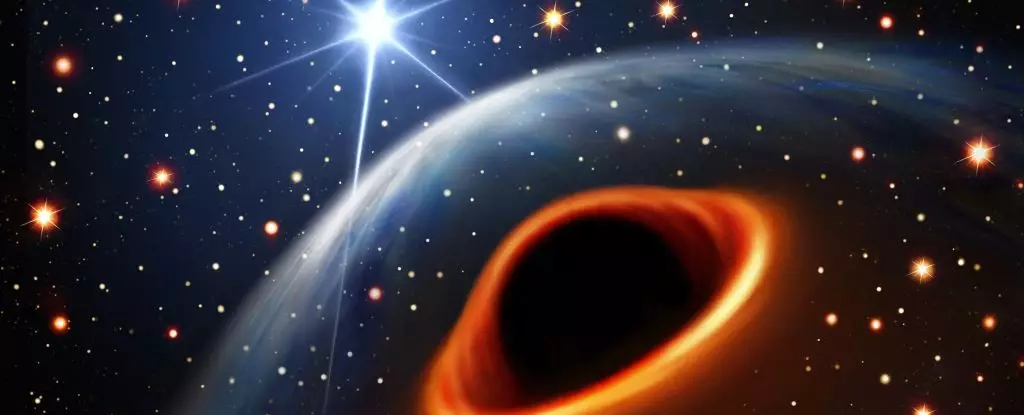

Far beyond the reaches of our solar system, approximately 5,825 light-years away, a red giant star has become the focus of intense astronomical scrutiny. Labeled G3425, this star is not merely twinkling in solitude; instead, it appears to be engaged in an unusual orbit with an unseen binary companion. What makes this observation particularly intriguing is the absence of light from this companion, a cosmic enigma hidden in a vast stretch of darkness. As astronomers delve deeper into this peculiar star’s peculiar motion, they find clues suggesting the presence of a black hole that defies traditional classifications.
Research led by the Chinese Academy of Sciences, particularly by astronomer Song Wang, has led scientists to postulate that the mass of this invisible object is approximately 3.6 times that of the Sun. This discovery situates G3425 in what is known as the “lower mass gap,” an area in black hole mass classification where few candidates have been detected. Typically, stellar remnants fuse into either white dwarfs or neutron stars before giving way to black holes, with significant mass gaps separating them from heavier black holes, which complicates our understanding of stellar evolution and the lifecycle of massive stars.
The theory posits that black holes within this mass range should be rare, indicating either a difficulty in detection or a genuine scarcity of such objects in the universe. Our methods of finding black holes are heavily reliant on their interactions with surrounding matter, particularly when they are voraciously consuming material that generates detectable X-ray emissions. The premise that lower-mass black holes might exist ‘invisible’ like G3425 pushes the boundaries of our research methodologies and theoretical frameworks.
The European Space Agency’s Gaia mission has significantly advanced our capabilities to unearth these elusive objects by constructing an intricate three-dimensional map of our galaxy. Gaia meticulously tracks the motion and velocity of celestial bodies, injecting a vital perspective into the search for these imperceptible companions. Utilizing spectroscopic data gathered from the Large Aperture Multi-Object Spectroscopic Telescope, Wang and his team were able to observe minute changes in the light emitted by G3425, providing critical insight into its interaction with the invisible entity it orbits.
Their observations revealed that the red giant has an estimated mass of about 2.7 solar masses, meticulously orchestrating what appears to be a circular orbit with a duration of around 880 days. This relatively stable circular path stands in stark contrast to the expected elliptical trajectories typically associated with binary systems formed by supernova explosions — an anomaly that begs for further investigation into the mechanisms that govern binary stellar evolution.
G3425’s characteristics challenge established theories regarding the formation of black holes from supernovae. The prevailing idea is that upon a supernova explosion, the resultant black hole’s momentum should often disrupt or alter the binary system’s trajectory significantly. Yet, G3425 presents a nearly pristine envelope of stability, suggesting that the dynamics of black hole formation are considerably more nuanced than previously understood.
The implications of G3425 extend beyond its binary partner; discovering more such systems could revolutionize our understanding of black hole populations across the universe. By gathering vast quantities of statistical data from similar low-mass black holes, astronomers can refine the models that describe their formation, shedding light on how black holes interact over time and across different stellar environments.
As researchers continue to investigate G3425, the broader implications of finding more low-mass black holes encompass our fundamental understanding of the universe’s evolution. Each new discovery may unveil particulars regarding star formation, the lifecycle of stellar remnants, and the complex gravitational interplays that govern the cosmos.
G3425 serves as a beacon illuminating the shadowy corners of our cosmic neighborhood, inviting us to explore the conceptual landscape of black holes and their formation. As we refine our observations and develop theories about these compact celestial objects, we edge ever closer to unraveling the profound mysteries of our universe. The existence of G3425 not only evokes curiosity but offers promising prospects for substantial advancements in astrophysical research. Thus, the search for low-mass black holes continues, reflecting humanity’s relentless quest for knowledge amidst the enigmatic expanses of space.
In the realm of software development, the ability to swiftly and accurately address bugs is…
The realm of quantum computing and communication is not just an abstract dream anymore; it…
In a remarkable leap for the field of material science, a collaborative research initiative has…
Throughout Earth's vast history, our planet has endured five major mass extinction events that reshaped…
Rainfall is a vital element of our planet’s hydrological cycle, yet many aspects of its…
On a night when the universe aligns, a mesmerizing phenomenon awaits: the appearance of the…
This website uses cookies.